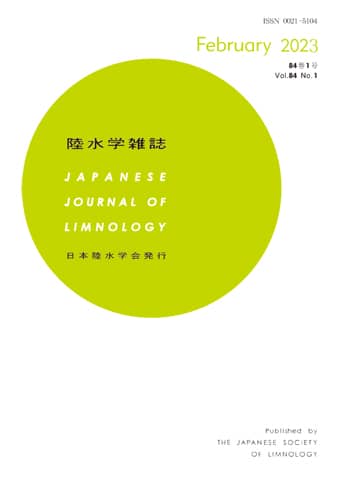
- |<
- <
- 1
- >
- >|
-
Hiroki HAGA, Minako ASHIYA, Yoichiro SAKAI, Kanako ISHIKAWA2023 Volume 84 Issue 3 Pages 175-185
Published: September 25, 2023
Released on J-STAGE: November 20, 2023
JOURNAL FREE ACCESSThe spatial distribution of submerged macrophytes, in terms of dry weight and species composition was surveyed at the end of August 2022 in the south basin of Lake Biwa. Submerged macrophytes were found at 38 of the 52 sampling sites, with an average biomass of 37.5 g m-2 per site. According to these findings, the estimated distribution range of submerged macrophytes in the basin was 37.7 km2, and the total biomass was 1936 t. Further, we identified 15 species and two genera of submerged macrophytes. Hydrilla verticillata was the most dominant species with a biomass of 714 t and Potamogeton wrightii was the second most dominant with a biomass of 360 t. Potamogeton maackianus, which dominated from 2002 to 2014, showed a severe decline. Compared with that in 2014, when this species reached its peak, its biomass and the number of appearance sites in 2022 had declined by 1/100 and less than half, respectively. Elodea nuttallii, Egeria densa, and Myriophyllum spicatum also declined markedly. In contrast, the abundance of H. verticillata and P. wrightii decreased slightly, whereas that of Najas marina increased significantly. Overall, the submerged flora in the south basin of Lake Biwa in 2022 were significantly different from those in the 2010s.
View full abstractDownload PDF (1481K) -
Jotaro URABE, Natsumi MARUOKA, Megumi ENOMOTO, Kohei Takenaka TAKANO, ...2023 Volume 84 Issue 3 Pages 187-201
Published: September 25, 2023
Released on J-STAGE: November 20, 2023
JOURNAL FREE ACCESSChlorophyll-a (chl-a), which reflects algal abundance, is an important determinant of water quality in lakes and reservoirs. In this study, we analyzed the mean chl-a abundance from 1990 to 2010 in 91 dam reservoirs located in southern and northern Japan. Although no significant annual trend in chl-a abundance was detected in all reservoirs during the observation period, we found a significant positive relationship between chl-a abundance and warmth index (or mean temperature) across the reservoirs. Using this relationship, we projected the chl-a abundance for 2076–2100 in each reservoir using a global climate model under the RCP 8.5 scenario. The results showed that the chl-a abundance in 2076–2100 was 2.2 times higher than the maximum abundance in the study period and, on an average, 1.5 times higher than that in 2000. To examine whether this increase in chl-a abundance could be attributed to the direct effects of warming, we further analyzed chl-a abundance using a structural equation model that included the indirect effects of warming through changes in land use/land cover in the reservoir watersheds. When indirect effects were considered, the direct effect of warming on chl-a abundance was no longer significant. Instead, the chl-a abundance was significantly related to the indirect effects of warming through changes in land use/land cover components in the watersheds. Based on these results, we discuss the importance of land use/land cover policies in managing the water quality in reservoirs under the influence of global warming.
View full abstractDownload PDF (2001K)
-
Hiroyuki TAKASU2023 Volume 84 Issue 3 Pages 203-217
Published: September 25, 2023
Released on J-STAGE: November 20, 2023
JOURNAL FREE ACCESSIn the year 1997, the inner part of Isahaya Bay on the west coast of Ariake Sea was separated from the sea by dikes, leading to the formation of a freshwater reservoir. Since the Isahaya Reclamation Project began in the 1990s, red tides and hypoxia have become more common in the bay. Eutrophic water from the reservoir is frequently discharged into the bay; therefore, nutrient and organic matter in the discharge may promote the occurrence of the red tides and hypoxia in the bay. In this review, I have discussed the impacts of the discharge on matter cycling, and its contribution to the occurrence of red tides and hypoxia in Isahaya Bay. In particular, I have focused on the interaction between organic matter in the discharge and microbes in Isahaya Bay, which is considered to significantly influence the red tides and hypoxia in this bay.
View full abstractDownload PDF (2180K)
- |<
- <
- 1
- >
- >|